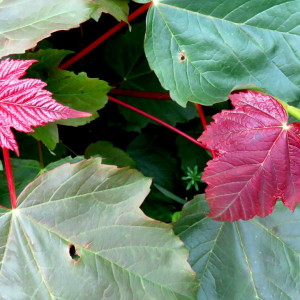Spring puce, or, no biting here
The first leaves of some trees are not green but distinctly pink or red, a fact that we seem to ignore when we celebrate the verdancy of spring.
Mollyblob's recent blip of delightfully coral-tinted young oak leaves reminded me of this phenomenon and set me on the track of finding out more about it. Following the path that leads me from home to town supplied numerous examples of young sycamore leaves: from these dull purplish ones to the carmine version in the appended image. But why?
The literature trail revealed that the colour is produced by pigments called anthocyanins that reflect red light. They are also responsible for the vivid colours of autumnal leaves as they are revealed when chlorophyll ceases to made. But why in spring?
Studies have been done and as a result it seems that a) the colour protects the delicate new leaves from damage by the sun especially on the long bright and often chilly days we have at this time of the year; b) herbivores of all kinds are instinctively attracted to green in terms of edibility, so, be they leaf-chewing insects or browsing mammals they would shy away from foliage at the red end of the spectrum; and c) anthocyanins are acidic and may taste off-putting if such a leaf is sampled.
So there you have it: whether these rosy tints provide young leaves with a built-in UV sun screen and/or a protective yuck factor, it seems they confer a survival benefit that has ensured their continuation even though the leaves' ability to photosynthesize may be compromised for a while.
The winding path of discovery led me down a further by-way in trying to decide on the colour of these leaves. I came up with puce as the best description. Thought I'd better check and yes, its a kind of dirty brownish-purple/pink hue just like this. The colour became fashionable in the 17th century, that age of grubby glamour, of frills, flounces and fleas. And indeed, the colour is named for the flea, puce in French. But why?? We all know fleas are black.
Well, it seems that people then were all too familiar with the the flea's propensity to bite and suck blood. If you were lucky enough to catch one on your person you had to crush its hard carapace between your nails in order to kill it and that would leave a spot of blood on your clothes or your bed sheets. Even after laundering (no biological wash powder then) a pinkish-brown stain would be left behind and that is what the colour puce is named after.
If you can bear it, there's an entertaining riff on this subject see here.
And, as a sideline , this.


Comments
Sign in or get an account to comment.


